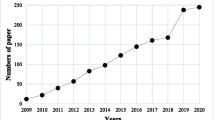Abstract
Understanding social interactions is one of the key factors in the development of context-aware ubiquitous applications. Identifying interaction patterns sensed by a mobile device is one possible way for understanding social interactions. Most previous studies on this problem have employed call and proximity logs to represent social interactions. Because these interactions can be characterized by topics, the studies have applied topic models based on latent Dirichlet allocation (LDA) to identifying interaction patterns from social interactions. However, these previous studies regarded calls and proximities as independent interaction types. As a result, they lost the information obtainable when calls and proximities were analyzed simultaneously. This paper proposes a topic-based method that simultaneously considers calls and proximities, allowing interaction patterns to be identified from a mobile log. For this purpose, the proposed method regards calls and proximities as a homogeneous information type that are drawn from the same temporal space expressed by the same distribution, but with different parameters. From the observation that the number of proximities in a mobile log usually overwhelms that of calls and the proximities are observed regularly, the proposed method models a single-directional influence from proximities to calls, where both call and proximity are modeled by LDA. The experiments with three different data sets from the Massachusetts Institute of Technology’s Reality Mining project show that the proposed method outperforms the method that considers calls and proximities independently; this proves the plausibility of the proposed method.











Similar content being viewed by others
Explore related subjects
Discover the latest articles, news and stories from top researchers in related subjects.References
Aharony N, Pan W, Ip C, Khayal I, Pentland A (2011) Social fMRI: investigating and shaping social mechanisms in the real world. Pervasive Mob Comput 7(6):643–659
Behmardi B, Raich R (2012) On confidence-constrained rank recovery in topic models. IEEE Trans Signal Process 60(10):5146–5162
Black M, Hickey R (2003) Learning classification rules for telecom customer call data under concept drift. Soft Comput 8(2):102–108
Blei D, Jordan M (2003) Modeling annotated data. In: Proceedings of the 26th ACM special interest group on information retrieval (SIGIR), pp 127–134
Blei D, Ng A, Jordan M (2003) Latent Dirichlet allocation. J Mach Learn Res 3:993–1022
Blei D, Carin L, Dunson D (2010) Probabilistic topic models. IEEE Signal Process Mag 27(6):55–65
Do T, Gatica-Perez D (2013) Human interaction discovery in smartphone proximity networks. Pers Ubiquit Comput 17(3):413–431
Dong W, Lepri B, Pentland A (2011) Modeling the co-evolution of behaviors and social relationships using mobile phone data. In: Proceedings of the 10th international conference on mobile and ubiquitous multimedia (MUM), pp 134–143
Eagle N, Pentland A (2006) Reality mining: sensing complex social systems. Pers Ubiquit Comput 10(4):255–268
Eagle N, Lazer D, Pentland A (2009) Inferring friendship network structure by using mobile phone data. Natl Acad Sci 106(36):15274–15278
Farrahi K, Gatica-Perez D (2010) Probabilistic mining of socio-geographic routines from mobile phone data. IEEE J Sel Top Signal 4(4):746–755
Farrahi K, Madan A, Cebrian M, Moturu S, Pentland A (2012) Sensing the “health state” of a community. Pervasive Comput 11(4):36–45
Gómez-Lopera J, Martínez-Aroza J, Robles-Pérez A, Román-Roldán R (2000) An analysis of edge detection by using the Jensen–Shannon divergence. J Math Imaging Vis 13(1):35–56
Griffiths T, Steyvers M (2004) Finding scientific topics. Natl Acad Sci 101(1):5228–5235
Han Y, Cheng S, Park S, Park S (2014) Finding social interaction patterns using call and proximity logs simultaneously. In: Proceedings of the 2014 IEEE/ACM international conference on advances in social network analysis and mining (ASONAM), pp 399–402
Huynh T, Fritz M, Schiele B (2008) Discovery of activity patterns using topic models. In: Proceedings of the 2008 ACM international joint conference on pervasive and ubiquitous computing (UbiComp), pp 10–19
Jung J (2009) Contextualized mobile recommendation service based on interactive social network discovered from mobile users. Exp Syst Appl 36(9):11950–11956
Madan A, Pentland A (2010) Modeling social diffusion phenomena using reality mining. In: Proceedings of AAAI spring symposium on human behavior modeling, pp 43–48
Mimno D, Wallach H, Naradowsky J, Smith D, McCallum A (2009) Polylingual topic models. In: Proceedings of the 2014 conference on empirical methods on natural language processing (EMNLP), pp 880–889
Minka T (2000) Estimating a Dirichlet distribution. https://faculty.cs.byu.edu/~ringger/CS679/papers/Heinrich-GibbsLDA.pdf. Accessed 15 July 2015
Mollenhorst G, Völker B, Flap H (2008) Social contexts and personal relationships: the effect of meeting opportunities on similarity for relationships of different strength. Soc Netw 30(1):60–68
Putthividhy D, Attias H, Nagarajan S (2010) Topic regression multi-modal latent Dirichlet allocation for image annotation. In: Proceedings of the IEEE conference on computer vision and pattern recognition (CVPR), pp 3408–3415
Singh V, Freeman L, Lepri B, Pentland A (2013) Classifying spending behavior using socio-mobile data. Human 2(2):99–111
Wei X, Croft W (2006) LDA-based document models for ad-hoc retrieval. In: Proceedings of the 29nd ACM special interest group on information retrieval (SIGIR), pp 178–185
Zheng J, Ni M (2013) An unsupervised learning approach to social circles detection in ego bluetooth proximity network. In: Proceedings of the 2014 ACM international joint conference on pervasive and ubiquitous computing (UbiComp), pp 721–724
Acknowledgments
This study was supported by the BK21 Plus project (SW Human Resource Development Program for Supporting Smart Life) funded by the Ministry of Education, School of Computer Science and Engineering, Kyungpook National University, Korea (21A20131600005).
Author information
Authors and Affiliations
Corresponding author
Ethics declarations
Conflict of interest
The authors declare that there is no conflict of interests regarding the publication of this paper.
Additional information
Communicated by W.-Y. Lin, H.-C. Yang, T.-P. Hong, L. S. L. Wang.
Rights and permissions
About this article
Cite this article
Han, YJ., Park, SY. & Park, SB. A single-directional influence topic model using call and proximity logs simultaneously. Soft Comput 21, 4179–4195 (2017). https://doi.org/10.1007/s00500-015-1898-8
Published:
Issue Date:
DOI: https://doi.org/10.1007/s00500-015-1898-8




